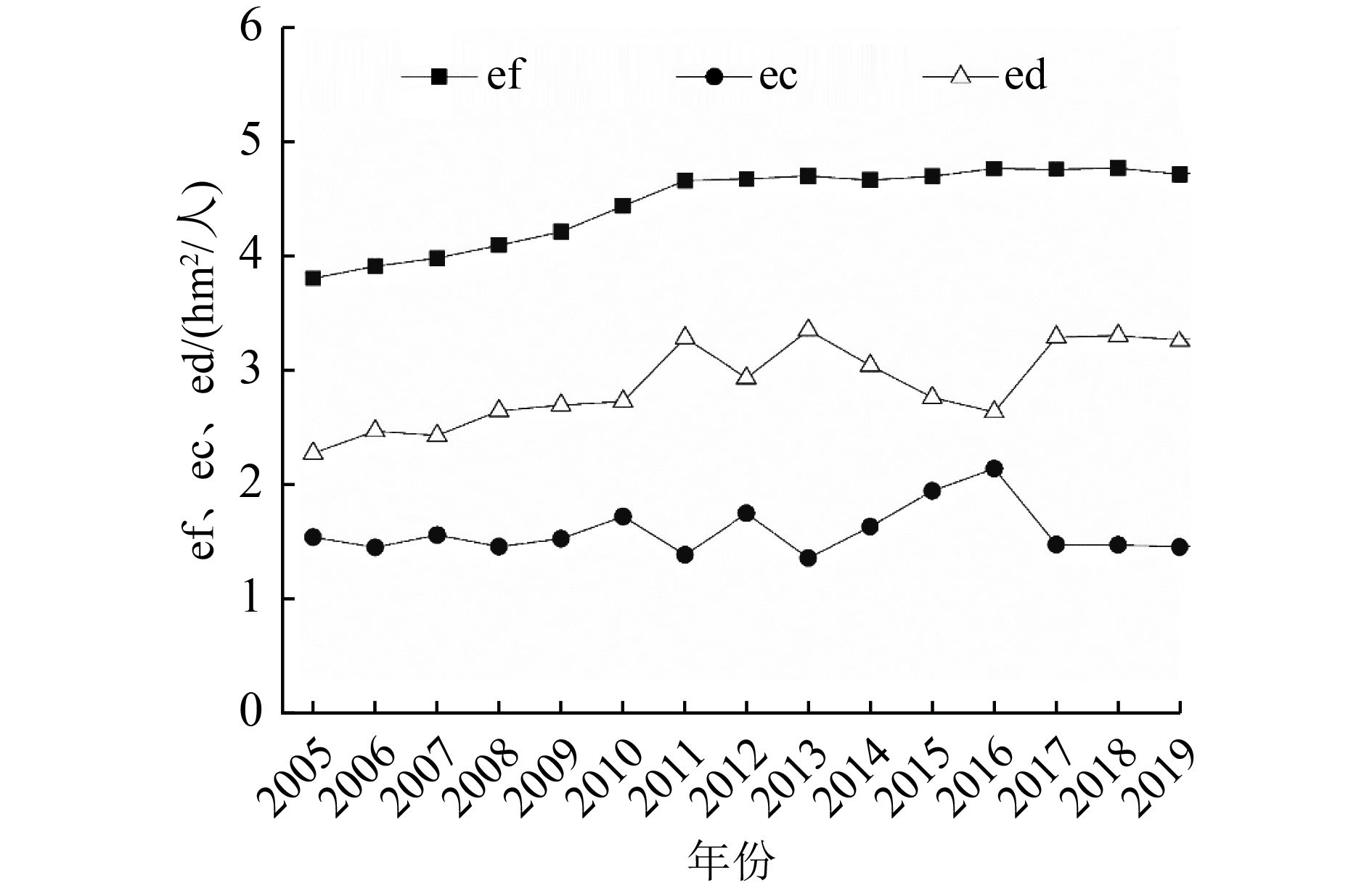Analysis of natural capital sustainability of the Yangtze River Delta urban agglomeration based on two-dimensional and three-dimensional ecological footprint models
-
摘要:
城镇化和工业化进程的不断推进给城市群自然资本及其可持续利用带来较大的威胁。为明确城市群建设过程中自然资本可持续性变化特征,以长三角城市群为研究对象,采用二维和三维生态足迹评价模型,同时添加水资源账户对原模型进行改进以反映长三角地区水资源潜力与压力,研究分析了2005—2019年长三角城市群生态足迹、生态压力指数和生态协调指数变化、自然资本存量消耗和自然资本流量占用情况及其影响因素与作用机制。结果表明:1)研究期间,长三角城市群人均生态足迹和生态承载力分别为4.46和1.59 hm2/人,平均人均生态赤字为2.87 hm2/人,但万元GDP生态足迹不断下降,资源利用率不断上升;2)2005—2019年,长三角城市群生态压力指数由2.48升至3.25,生态协调指数由1.30变为1.25;3)基于改进三维生态足迹模型发现,长三角城市群资本存量利用程度越来越大,且对自然资本流量的更新起到较大抑制作用,2019年研究区自然资本存量的消耗量是资本流量占有量的2.26倍;4)影响因子分析表明,工业产值、能源消耗总量、建筑用地面积和城镇化率对生态足迹起到了正向促进作用,对自然资本的可持续性产生了较大压力。
Abstract:The continuous advancement of urbanization and industrialization has greatly threatened the natural capital and its sustainable utilization in urban agglomeration. In order to clarify the characteristics of natural capital sustainability changes during the construction process of urban agglomerations, taking the Yangtze River Delta urban agglomerations as an example, two-dimensional and three-dimensional ecological footprint models were applied to analyze the change of ecological footprint, ecological pressure index (EPI) and ecological economic coordination index (EECI), the natural capital stock consumption and natural capital flow occupancy, as well as the influencing factors and its related mechanisms, by adding the water resources account to the adapted ecological footprint model to reflect the water resource potential and demand in this area. The results showed that during the study period, the per capita ecological footprint and ecological carrying capacity of the Yangtze River Delta urban agglomeration were 4.46 hm2/person and 1.59 hm2/person, respectively; and the average per capita ecological deficit was 2.87 hm2/person; however, the ecological footprint per unit GDP continued to decline, indicating that the utilization rate of resources continued to rise. From 2005 to 2019, the EPI value of the Yangtze River Delta urban agglomeration increased from 2.48 to 3.25, and the EECI value fell from 1.30 to 1.25. Based on the revised three-dimensional ecological footprint model, it was found that the use of natural capital stock in the Yangtze River Delta urban agglomeration was increasing, and it had a significant inhibitory effect on the renewal of natural capital flows, and the consumption of natural capital stock was 2.26 times of capital flow in 2019, with the resource consumption occupied. The impact factors analysis showed that the industrial output value, total energy consumption, construction land area and urbanization rate played positive roles in promoting the ecological footprint and exerted greater pressure on the sustainability of natural capital. The relationships among the ecological pressure level, ecological environmental and economic development of the Yangtze River Delta urban agglomeration were quantitatively analyzed to provide a scientific basis and decision support for improving the ecological security and sustainable development of urban agglomerations.
-
表 1 生态压力指数分级
Table 1. The scale of ecological pressure index
生态安全等级 EPI 安全等级 1 ≤0.5 十分安全 2 0.5~0.8 较安全 3 0.81~1.00 一般 4 1.01~1.50 不安全 5 1.51~2.00 很不安全 6 >2.00 极不安全 表 2 数据来源及说明
Table 2. Data source and description
项目 指标选取 数据来源 社会、经济、人口、消费
数据GDP、常住人口、工业产值、
固定资产投资、财政收入、
城镇居民收入、城镇化率各省市统计年鉴 生物资源
数据耕地:粮食、蔬菜、棉花、
瓜果、油料等作物产量
林地:水果、茶叶、木材、
油茶籽、油桐籽等林产品产量
草地:猪肉、牛肉、羊肉、
禽肉、禽蛋、奶类产品产量
水域:水产品产量各省市统计年鉴 能源消耗
数据化石燃料:煤炭、焦炭、原油、
汽油、煤油、柴油、燃料油、
天然气消耗量
能源动力:电力使用量《中国能源统计
年鉴》土地利用
数据各地类土地利用面积 自然资源部网站及
《自然资源与环境统计年鉴》水资源数据 生活、生产及生态环境
用水量和水资源总量各省市水资源公报 -
[1] LU Y L, ZHANG Y Q, CAO X H, et al. Forty years of reform and opening up: China's progress toward a sustainable path[J]. Science Advances,2019,5(8):eaau9413. doi: 10.1126/sciadv.aau9413 [2] YANG C, LI Q Q, HU Z W, et al. Spatiotemporal evolution of urban agglomerations in four major bay areas of US, China and Japan from 1987 to 2017: evidence from remote sensing images[J]. Science of the Total Environment,2019,671:232-247. doi: 10.1016/j.scitotenv.2019.03.154 [3] 刘晟东, 史君楠, 程勇, 等.中国典型城市群PM2.5污染特征研究进展[J]. 环境科学研究,2020,33(2):243-251.LIU S D, SHI J N, CHENG Y, et al. Review of pollution characteristics of PM2.5 in Chinese representative megacities[J]. Research of Environmental Sciences,2020,33(2):243-251. [4] 施生旭, 童佩珊.基于CiteSpace的城市群生态安全研究发展态势分析[J]. 生态学报,2018,38(22):8234-8246.SHI S X, TONG P S. Ananalysis of ecological security of the urban agglomeration development trend based on CiteSpace econometric analysis[J]. Acta Ecologica Sinica,2018,38(22):8234-8246. [5] 徐泽, 李储, 牛陆.呼包鄂榆城市群土地混合利用与碳排放的脱钩关系[J]. 环境科学研究,2022,35(1):299-308.XU Z, LI C, NIU L. Decoupling relationship between land mixed use and carbon emissions in Hohhot-Baotou-Ordos-Yulin urban agglomeration[J]. Research of Environmental Sciences,2022,35(1):299-308. [6] YANG Y, CAI Z X. Ecological security assessment of the Guanzhong Plain urban agglomeration based on an adapted ecological footprint model[J]. Journal of Cleaner Production,2020,260:120973. doi: 10.1016/j.jclepro.2020.120973 [7] REES W E. Ecological footprints and appropriated carrying capacity: what urban economics leaves out[J]. Environment and Urbanization,1992,4(2):121-130. doi: 10.1177/095624789200400212 [8] PENG J, DU Y Y, MA J, et al. Sustainability evaluation of natural capital utilization based on 3DEF model: a case study in Beijing City, China[J]. Ecological Indicators,2015,58:254-266. doi: 10.1016/j.ecolind.2015.06.002 [9] WACKERNAGEL M. Biological footprint and appropriated carrying capacity: a tool for planning toward sustainability[D]. Vancouver, British Columbia, Canada: The University of British Columbia, 1994. [10] MUÑIZ I, GALINDO A. Urban form and the ecological footprint of commuting. the case of Barcelona[J]. Ecological Economics,2005,55(4):499-514. doi: 10.1016/j.ecolecon.2004.12.008 [11] HU D, HUANG S L, FENG Q, et al. Relationships between rapid urban development and the appropriation of ecosystems in Jiangyin City, Eastern China[J]. Landscape and Urban Planning,2008,87(3):180-191. doi: 10.1016/j.landurbplan.2008.06.001 [12] NICCOLUCCI V, BASTIANONI S, TIEZZI E B P, et al. How deep is the footprint?A 3D representation[J]. Ecological Modelling,2009,220(20):2819-2823. doi: 10.1016/j.ecolmodel.2009.07.018 [13] NICCOLUCCI V, GALLI A, REED A, et al. Towards a 3D national ecological footprint geography[J]. Ecological Modelling,2011,222(16):2939-2944. doi: 10.1016/j.ecolmodel.2011.04.020 [14] 方恺.生态足迹深度和广度: 构建三维模型的新指标[J]. 生态学报,2013,33(1):267-274. doi: 10.5846/stxb201111051670FANG K. Ecological footprint depth and size: new indicators for a 3D model[J]. Acta Ecologica Sinica,2013,33(1):267-274. doi: 10.5846/stxb201111051670 [15] 王业宁, 周强, 王豪伟.中国34个省级行政区三维生态足迹动态研究[J]. 生态学报,2020,40(18):6434-6444.WANG Y N, ZHOU Q, WANG H W. Assessing three-dimensional ecological footprint of 34 provinces in China[J]. Acta Ecologica Sinica,2020,40(18):6434-6444. [16] 苏子龙, 袁国华, 周伟.基于改进三维生态足迹模型的安徽省土地生态承载力评价[J]. 水土保持研究,2020,27(3):256-262.SU Z L, YUAN G H, ZHOU W. Evaluation of land carrying capacity in Anhui Province based on revised three-dimensional ecological footprint model[J]. Research of Soil and Water Conservation,2020,27(3):256-262. [17] 伍芮, 李成英.基于三维生态足迹模型的西宁市生态可持续性研究[J]. 攀登,2020,39(2):83-88.WU R, LI C Y. Study on ecological sustainability of Xining City based on three-dimensional ecological footprint model[J]. New Heights,2020,39(2):83-88. [18] 王金南, 孙宏亮, 续衍雪, 等.关于“十四五”长江流域水生态环境保护的思考[J]. 环境科学研究,2020,33(5):1075-1080.WANG J N, SUN H L, XU Y X, et al. Water eco-environment protection framework in the Yangtze River Basin during the 14th Five-year Plan period[J]. Research of Environmental Sciences,2020,33(5):1075-1080. [19] 李海生,杨鹊平,赵艳民.聚焦水生态环境突出问题,持续推进长江生态保护修复[J]. 环境工程技术学报,2022,12(2):336-347. doi: doi:10.12153/j.issn.1674-991X.20220091LI H S,YANG Q P,ZHAO Y M. Focusing on water eco-environment problems and sustainably promoting ecological conservation and restoration of the Yangtze River[J]. Journal of Environmental Engineering Technology,2022,12(2):336-347. doi: doi:10.12153/j.issn.1674-991X.20220091 [20] YANG Q, LIU G Y, HAO Y, et al. Quantitative analysis of the dynamic changes of ecological security in the provinces of China through emergy-ecological footprint hybrid indicators[J]. Journal of Cleaner Production,2018,184:678-695. doi: 10.1016/j.jclepro.2018.02.271 [21] CHEN H S. Evaluation and analysis of eco-security in environmentally sensitive areas using an emergy ecological footprint[J]. International Journal of Environmental Research and Public Health,2017,14(2):136. doi: 10.3390/ijerph14020136 [22] LIN D, HANSCOM L, MURTHY A, et al. Ecological footprint accounting for countries: updates and results of the national footprint accounts, 2012-2018[J]. Resources,2018,7(3):58. doi: 10.3390/resources7030058 [23] 刘某承, 李文华, 谢高地.基于净初级生产力的中国生态足迹产量因子测算[J]. 生态学杂志,2010,29(3):592-597. doi: 10.13292/j.1000-4890.2010.0097LIU M C, LI W H, XIE G D. Estimation of China ecological footprint production coefficient based on net primary productivity[J]. Chinese Journal of Ecology,2010,29(3):592-597. doi: 10.13292/j.1000-4890.2010.0097 [24] 杜悦悦, 彭建, 高阳, 等.基于三维生态足迹的京津冀城市群自然资本可持续利用分析[J]. 地理科学进展,2016,35(10):1186-1196. doi: 10.18306/dlkxjz.2016.10.002DU Y Y, PENG J, GAO Y, et al. Sustainability evaluation of natural capital utilization based on a three-dimensional ecological footprint model: a case study of the Beijing-Tianjin-Hebei Metropolitan region[J]. Progress in Geography,2016,35(10):1186-1196. doi: 10.18306/dlkxjz.2016.10.002 [25] 金梦婷, 徐丽萍, 李鹏辉.南北疆区域经济差异化三维生态足迹自然资本利用的时空演变[J]. 生态学报,2020,40(13):4327-4339.JIN M T, XU L P, LI P H. Spatial and temporal evolution of natural capital utilization in the three-dimensional ecological footprint under the regional economic differentiation in north and south Xinjiang[J]. Acta Ecologica Sinica,2020,40(13):4327-4339. [26] 温飞, 邵月花, 谈存峰.渭河干流甘肃段生态足迹与承载力评价分析[J]. 环境工程技术学报,2021,11(5):983-991. doi: 10.12153/j.issn.1674-991X.20210236WEN F, SHAO Y H, TAN C F. Evaluation and analysis of ecological footprint and carrying capacity of the mainstream of Weihe River in Gansu Province[J]. Journal of Environmental Engineering Technology,2021,11(5):983-991. doi: 10.12153/j.issn.1674-991X.20210236 [27] 李青.基于绿色发展的城市群规划及实施刍议: 以长江三角洲城市群规划为例[J]. 中国发展,2018,18(5):9-12.LI Q. Planning and implementation of urban agglomeration based on green development:taking the urban agglomeration planning of the Yangtze River Delta as an example[J]. China Development,2018,18(5):9-12. [28] 宋雪珺. 长三角城市群生态盈亏的时空格局及影响因素研究[D]. 上海: 华东师范大学, 2017. [29] 金昌盛, 邓仁健, 刘俞希, 等.长江经济带水资源生态足迹时空分析及预测[J]. 水资源与水工程学报,2018,29(4):59-66.JIN C S, DENG R J, LIU Y X, et al. Research for spatio-temporal analysis and prediction of water resource ecological footprint in Yangtze River Economic Belt[J]. Journal of Water Resources and Water Engineering,2018,29(4):59-66. [30] 陈炳, 曾刚, 曹贤忠, 等.长三角城市群生态文明建设与城市化耦合协调发展研究[J]. 长江流域资源与环境,2019,28(3):530-541.CHEN B, ZENG G, CAO X Z, et al. Coupling coordination development between ecological civilization construction and urbanization in Yangtze River Delta urban agglomerations[J]. Resources and Environment in the Yangtze Basin,2019,28(3):530-541. [31] 闻熠, 高峻, 徐迪, 等.基于改进参数的长三角城市生态足迹分析及其可持续性评价[J]. 水土保持研究,2020,27(1):312-318.WEN Y, GAO J, XU D, et al. Analysis on ecological footprint and evaluation of sustainability of typical cities in Yangtze River Delta based on improved parameters[J]. Research of Soil and Water Conservation,2020,27(1):312-318. [32] 闻熠, 高峻, 姚扬, 等.基于改进参数的长三角城市群生态足迹时空动态及驱动因子分析[J]. 环境工程技术学报,2020,10(1):133-141. doi: 10.12153/j.issn.1674-991X.20190061WEN Y, GAO J, YAO Y, et al. Spatial and temporal dynamics and driving factor analysis of ecological footprint of Yangtze River Delta urban agglomeration based on improved parameters[J]. Journal of Environmental Engineering Technology,2020,10(1):133-141. doi: 10.12153/j.issn.1674-991X.20190061 [33] 郑德凤, 刘晓星, 王燕燕, 等.基于三维生态足迹的中国自然资本利用时空演变及驱动力分析[J]. 地理科学进展,2018,37(10):1328-1339. doi: 10.18306/dlkxjz.2018.10.003ZHENG D F, LIU X X, WANG Y Y, et al. Spatiotemporal evolution and driving forces of natural capital utilization in China based on three-dimensional ecological footprint[J]. Progress in Geography,2018,37(10):1328-1339. doi: 10.18306/dlkxjz.2018.10.003 [34] 程钰, 尹建中, 王建事.黄河三角洲地区自然资本动态演变与影响因素研究[J]. 中国人口·资源与环境,2019,29(4):127-136.CHENG Y, YIN J Z, WANG J S. Research on natural capital evolution and influencing factors in the Yellow River Delta Region[J]. China Population, Resources and Environment,2019,29(4):127-136. [35] 张星星, 曾辉.珠江三角洲城市群三维生态足迹动态变化及驱动力分析[J]. 环境科学学报,2017,37(2):771-778.ZHANG X X, ZENG H. Dynamic of three dimensional ecological footprint in the Pearl River Delta and its driving factors[J]. Acta Scientiae Circumstantiae,2017,37(2):771-778. ◇ -





 下载:
下载:







